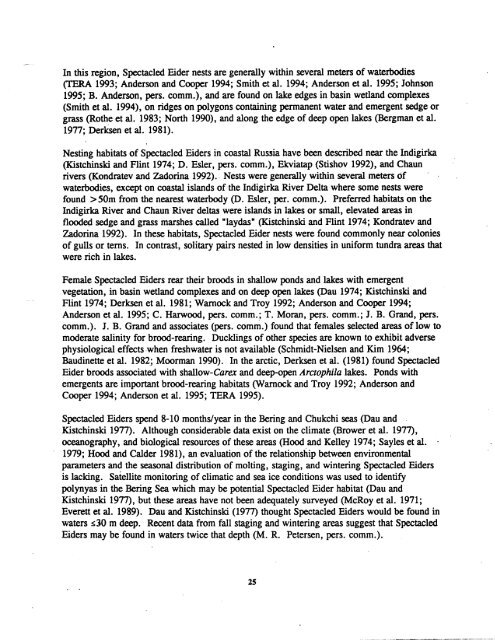A. Status of the Spectacled Eider - U.S. Fish and Wildlife Service
A. Status of the Spectacled Eider - U.S. Fish and Wildlife Service
A. Status of the Spectacled Eider - U.S. Fish and Wildlife Service
Create successful ePaper yourself
Turn your PDF publications into a flip-book with our unique Google optimized e-Paper software.
In this region, <strong>Spectacled</strong> <strong>Eider</strong> nests are generally within several meters <strong>of</strong> waterbodies<br />
(TERA 1993; Anderson <strong>and</strong> Cooper 1994; Smith et al. 1994; Anderson et al. 1995; Johnson<br />
1995; B. Anderson, pers. comm.), <strong>and</strong> are found on lake edges in basin wetl<strong>and</strong> complexes<br />
(Smith et al. 1994), on ridges on polygons containing permanent water <strong>and</strong> emergent sedge or<br />
grass (Ro<strong>the</strong> et al. 1983; North 1990), <strong>and</strong> along <strong>the</strong> edge <strong>of</strong> deep open lakes (Bergman et al.<br />
1977; Derksen et al. 1981).<br />
Nesting habitats <strong>of</strong> <strong>Spectacled</strong> <strong>Eider</strong>s in coastal Russia have been described near <strong>the</strong> Indigirka<br />
(Kistchinski <strong>and</strong> Flint 1974; D. Esler, pers. comm.), Ekviatap (Stishov 1992), <strong>and</strong> Chaun<br />
rivers (Kondratev <strong>and</strong> Zadorina 1992). Nests were generally within several meters <strong>of</strong><br />
waterbodies, except on coastal isl<strong>and</strong>s <strong>of</strong> <strong>the</strong> Indigirka River Delta where some nests were<br />
found > SOm from <strong>the</strong> nearest waterbody (D. Esler, per. comm.). Preferred habitats on <strong>the</strong><br />
Indigirka River <strong>and</strong> Chaun River deltas were isl<strong>and</strong>s in lakes or small, elevated areas in<br />
flooded sedge <strong>and</strong> grass marshes called “laydas” (Kistchinski <strong>and</strong> Flint 1974; Kondratev <strong>and</strong><br />
Zadorina 1992). In <strong>the</strong>se habitats, <strong>Spectacled</strong> <strong>Eider</strong> nests were found commonly near colonies<br />
<strong>of</strong> gulls or terns. In contrast, solitary pairs nested in low densities in uniform tundra areas that<br />
were rich in lakes.<br />
Female <strong>Spectacled</strong> <strong>Eider</strong>s rear <strong>the</strong>ir broods in shallow ponds <strong>and</strong> lakes with emergent<br />
vegetation, in basin wetl<strong>and</strong> complexes <strong>and</strong> on deep open lakes (Dau 1974; Kistchinski <strong>and</strong><br />
Flint 1974; Derksen et al. 1981; Warnock <strong>and</strong> Troy 1992; Anderson <strong>and</strong> Cooper 1994;<br />
Anderson et al. 1995; C. Harwood, pers. comm.; T. Moran, pers. comm.; J. B. Gr<strong>and</strong>, pers.<br />
comm.). J. B. Gr<strong>and</strong> <strong>and</strong> associates (pers. comm.) found that females selected areas <strong>of</strong> low to<br />
moderate salinity for brood-rearing. Ducklings <strong>of</strong> o<strong>the</strong>r species are known to exhibit adverse<br />
physiological effects .when freshwater is not available (Schmidt-Nielsen <strong>and</strong> Kim 1964;<br />
Baudinette et al. 1982; Moorman 1990). In <strong>the</strong> arctic, Derksen et al. (1981) found <strong>Spectacled</strong><br />
<strong>Eider</strong> broods associated with shallow-Carex <strong>and</strong> deep-open Arctophila lakes. Ponds with<br />
emergents are important brood-rearing habitats (Warnock <strong>and</strong> Troy 1992; Anderson <strong>and</strong><br />
Cooper 1994; Anderson et al. 1995; TERA 1995).<br />
<strong>Spectacled</strong> <strong>Eider</strong>s spend 8-10 months/year in <strong>the</strong> Bering <strong>and</strong> Chukchi seas (Dau <strong>and</strong><br />
Kistchinski 1977). Although considerable data exist on <strong>the</strong> climate (Brower et al. 1977),<br />
oceanography, <strong>and</strong> biological resources <strong>of</strong> <strong>the</strong>se areas (Hood <strong>and</strong> Kelley 1974; Sayles et al.<br />
1979; Hood <strong>and</strong> Calder 1981), an evaluation <strong>of</strong><strong>the</strong> relationship between environmental<br />
parameters <strong>and</strong> <strong>the</strong> seasonal distribution <strong>of</strong> molting, staging, <strong>and</strong> wintering <strong>Spectacled</strong> <strong>Eider</strong>s<br />
is lacking. Satellite monitoring <strong>of</strong> climatic <strong>and</strong> sea ice conditions was used to identify<br />
polynyas in <strong>the</strong> Bering Sea which may be potential <strong>Spectacled</strong> <strong>Eider</strong> habitat (Dau <strong>and</strong><br />
Kistchinski 1977), but <strong>the</strong>se areas have not been adequately surveyed (McRoy et al. 1971;<br />
Everett et al. 1989). Dau <strong>and</strong> Kistchinski (1977) thought <strong>Spectacled</strong> <strong>Eider</strong>s would be found in<br />
waters =30m deep. Recent data from fall staging <strong>and</strong> wintering areas suggest that <strong>Spectacled</strong><br />
<strong>Eider</strong>s may be found in waters twice that depth (M. R. Petersen, pers. comm.).<br />
25

















